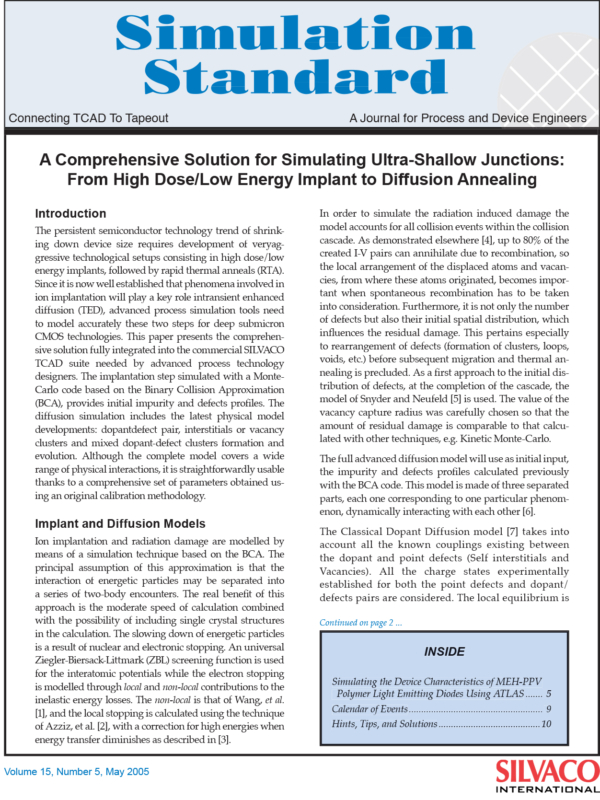A Comprehensive Solution for Simulating Ultra-Shallow Junctions: From High Dose/Low Energy Implant to Diffusion Annealing
Introduction
The persistent semiconductor technology trend of shrinking down device size requires development of veryaggressive technological setups consisting in high dose/low energy implants, followed by rapid thermal anneals (RTA). Since it is now well established that phenomena involved in ion implantation will play a key role intransient enhanced diffusion (TED), advanced process simulation tools need to model accurately these two steps for deep submicron CMOS technologies. This paper presents the comprehensive solution fully integrated into the commercial SILVACO TCAD suite needed by advanced process technology designers. The implantation step simulated with a Monte-Carlo code based on the Binary Collision Approximation (BCA), provides initial impurity and defects profiles. The diffusion simulation includes the latest physical model developments: dopantdefect pair, interstitials or vacancy clusters and mixed dopant-defect clusters formation and evolution. Although the complete model covers a wide range of physical interactions, it is straightforwardly usable thanks to a comprehensive set of parameters obtained using an original calibration methodology.
Implant and Diffusion Models
Ion implantation and radiation damage are modelled by means of a simulation technique based on the BCA. The principal assumption of this approximation is that the interaction of energetic particles may be separated into a series of two-body encounters. The real benefit of this approach is the moderate speed of calculation combined with the possibility of including single crystal structures in the calculation. The slowing down of energetic particles is a result of nuclear and electronic stopping. An universal Ziegler-Biersack-Littmark (ZBL) screening function is used for the interatomic potentials while the electron stopping is modelled through local and non-local contributions to the inelastic energy losses. The non-local is that of Wang, et al. [1], and the local stopping is calculated using the technique of Azziz, et al. [2], with a correction for high energies when energy transfer diminishes as described in [3].
In order to simulate the radiation induced damage the model accounts for all collision events within the collision cascade. As demonstrated elsewhere [4], up to 80% of the created I-V pairs can annihilate due to recombination, so the local arrangement of the displaced atoms and vacancies, from where these atoms originated, becomes important when spontaneous recombination has to be taken into consideration. Furthermore, it is not only the number of defects but also their initial spatial distribution, which influences the residual damage. This pertains especially to rearrangement of defects (formation of clusters, loops, voids, etc.) before subsequent migration and thermal annealing is precluded. As a first approach to the initial distribution of defects, at the completion of the cascade, the model of Snyder and Neufeld [5] is used. The value of the vacancy capture radius was carefully chosen so that the amount of residual damage is comparable to that calculated with other techniques, e.g. Kinetic Monte-Carlo.



